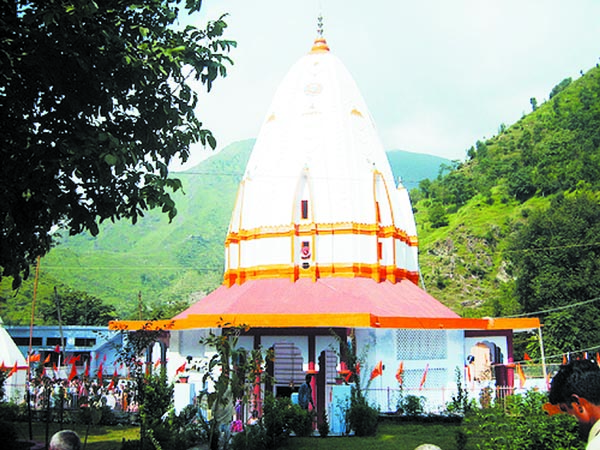KD Maini
Swami Budha Amarnath Temple is situated in between the main belt of Pir Panchal range at Rajpura Mandi which is 23 kilometers on the north east of Poonch city. This sacred place is located on the confluence of two gushing streams namely Nallah Gagri and Pulsta Nadi. This place is surrounded by snow bound lofty peaks, thick belt of fir forests (in the eastern side), lush green pastures and crystal clear streams and nallahs. The climate of this attractive and charming spot is very pleasant and cool. At present Swami Budha Amarnath temple is connected with a motorable road and it is 244 kilometers from Jammu.
The original temple has been carved out of one big stone. There are four doors in the temple on the northern, southern, eastern and western sides which indicates that the doors of this shrine are open for all the four varnas. There is a natural Shivlinga of white stone (Chakmak) inside the temple. A number of ancient idols collected from nearby villages have also been installed in the premises of the temple where there were four holy springs in the past. At present the water of three springs has been diverted to fourth one which is on the southern side of the temple. The water of these springs is considered holy from religious point of view. The pilgrims first take bath in this spring and then enter the temple for prayers.
Thousands of pilgrims with great devotion come to this place from various parts of the country every year. The main religious function is held on the occasion of Raksha Bandhan which is known as Mela Swami Budha Amarnath Festival. Three days before the Mela, a religious congregation is held at Dashnami Akhara Poonch for Havan and Pooja of Chari Mubarakh.
The procession of Chari Mubarakh starts from Akhara in between the chanting of bhajans and religious slogans. A guard of honour from Police contingents is paid to Chari Mubarakh at the gate of the Akhara. The Swami Ji is carried in a palki by the devotees, along with the sacred mace. Thousands of devotees and hundreds of Sadhus accompany the procession which leads towards Swami Budha Amarnath on foot. The main halt is at Chandak, (the name of the Chandaka Devi) where lunch is served to the yartis. While on the way from Poonch to Mandi, a number of stalls remain erected for welcoming the Charri Mubarakh and yatries. At Chandak, light drinks are served by a prominent Muslim of Chandak to yatries. The procession reaches Rajpura on the same day in the afternoon where it is received by the local people, sadhus and workers of the Trust after guard of honour by the BSF contingent at the gate of Swami Budha Amarnath. The Charri Mubarakh is taken to the main shrine in between the traditional rituals followed by the Aarti of Lord Shiva.
On the occasion of Raksha Bandan, thousands of pilgrims from Poonch, Rajouri, Jammu and other parts of the country have darshan of Charri Mubarakh and holy shrine. After performing the religious rituals, the devotees come out of the shrine with great joy and satisfaction. Then the langer starts in which people of all sections sit together in a row and have their lunch. The District Administration along with the Managing Committee makes all adequate arrangements for the comfortable stay of yatries. By this way, this religious function takes the shape of public festival in which people of all section take part.
This holy place has great religious importance. It is said that at this very place Lord Shiva had started narrating Amar Katha to Parvati Ji which ended at Swami Amarnath located near Pahalgam Kashmir. This temple is considered older than the Swami Amarnath Ji of Kashmir. This is why the shrine is known as Swami Budha Amarnath. It is believed that one must visit this sacred place before performing the yatra of Amarnath Kashmir.
A number of legends are famous in and around Poonch city regarding the eruption of this ancient temple. As per one legend, Mahatma Pulsta (the grandfather of Kind Ravana of Sri Lanka) meditated at this very place for a pretty long time. He was devotee of Lord Shiva. There are number of references in Neel Mat Puran about Pulsata Rishi. As per these references, Pulsat was also an artist and sculptor. He erected number of images of God.
The legend goes that Pulsata meditated with such a devotion at Rajpura Mandi that Lord Shiva gave him Darshan at this very place. In the memory of Darshana of Lord Shiva, Rishi Pulsata constructed the temple of Shiva and erected a lingum there. Since the Pulsata was a great Rishi, a sculptor and very popular among the habitants of this area, therefore, after his death the people converted this small temple into a shrine. Later on this shrine took the name of Swami Budha Amarnath. Even now a number of idols of ancient time are available in this area. It is possible that these idols may have been installed by Pulsat Rishi.


